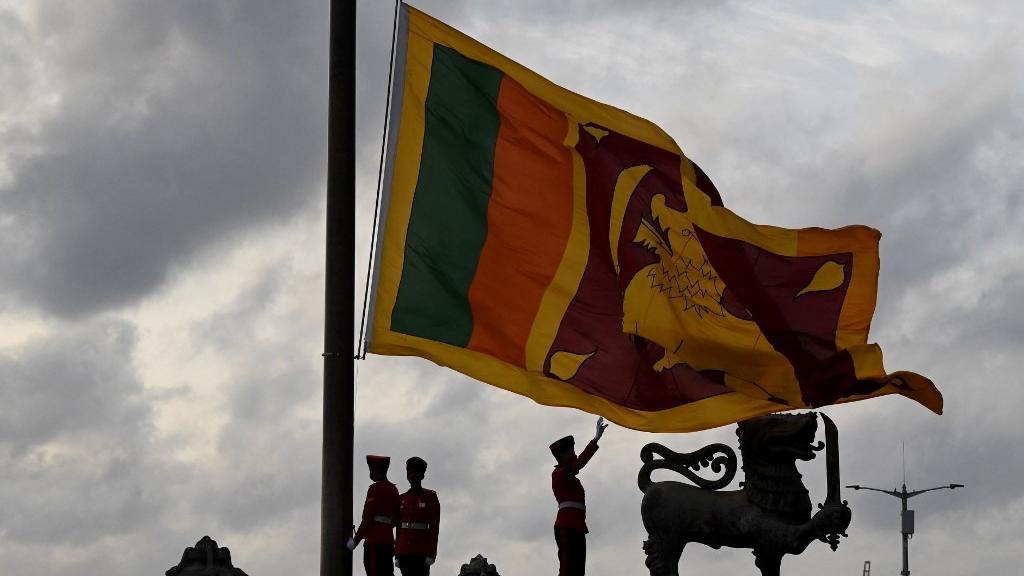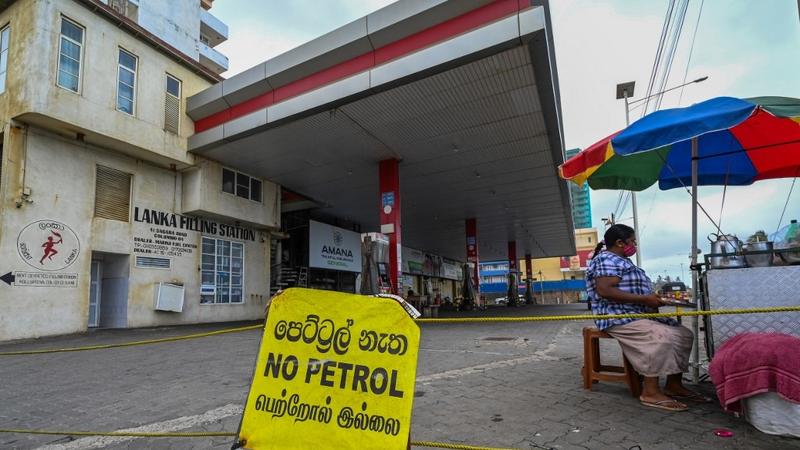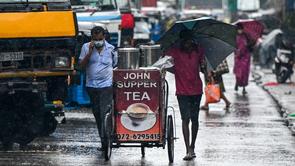 Military personnel in ceremonial uniform lower the Sri Lanka national flag at Galle Face Green in Colombo on July 23, 2022. (ARUN SANKAR / AFP)
Military personnel in ceremonial uniform lower the Sri Lanka national flag at Galle Face Green in Colombo on July 23, 2022. (ARUN SANKAR / AFP)
COLOMBO - Sri Lanka's central bank on Thursday threatened administrative intervention to control high market interest rates that it regarded as out of line with the inflation outlook.
Any such action, interpreted by economists as meaning it might push market rates down, would lower the government's high borrowing costs. However, it was unclear how the central bank could force investors to support public finances at lower rates than they expected.
The Central Bank of Sri Lanka (CBSL) also confirmed an expected decision to hold its two policy rates steady, citing a need to curb demand in the economy. The Standing Lending Facility rate was kept at 15.50 percent and the Standing Deposit Facility Rate at 14.50 percent
The Central Bank of Sri Lanka (CBSL) also confirmed an expected decision to hold its two policy rates steady, citing a need to curb demand in the economy. The Standing Lending Facility rate was kept at 15.50 percent and the Standing Deposit Facility Rate at 14.50 percent.
Market rates on longer-term government debt - bonds and treasury bills - are about twice as high as those policy rates for overnight money, increasing the government's burden in covering its budget deficit and refinancing maturing debt.
"If an appropriate downward adjustment in the market interest rates would not take place in line with the envisaged disinflation path, the central bank will be compelled to impose administrative measures to prevent any undue movements in market interest rates," CBSL said in a statement.
The island nation has been struggling with soaring inflation, partly triggered by its worst financial crisis in seven decades and an ill-considered ban on chemical fertilizers implemented last year and since reversed.
ALSO READ: Sri Lanka budget to seek recovery for crisis-hit economy
 A sign reading 'No Petrol' is seen at a closed Ceylon Petroleum Corporation fuel station in Colombo Aug 26, 2022.
(ISHARA S. KODIKARA / AFP)
A sign reading 'No Petrol' is seen at a closed Ceylon Petroleum Corporation fuel station in Colombo Aug 26, 2022.
(ISHARA S. KODIKARA / AFP)
A shortage of foreign exchange reserves to pay for essential imports has added to inflation and triggered a sharp currency depreciation that has also pushed up prices.
The nationwide consumer price index in October was 70.6 percent higher than a year earlier. But the central bank expects that restrained fiscal policy, if sustained, and its tight monetary policy will pull the annual inflation rate down to 4-5 percent by the end of 2023.
The nationwide consumer price index in October was 70.6 percent higher than a year earlier. But the central bank expects that restrained fiscal policy, if sustained, and its tight monetary policy will pull the annual inflation rate down to 4-5 percent by the end of 2023
The statement is clear on CBSL wanting market interest rates to be on a downward path in the months ahead, citing moderation in inflation in particular," said Thilina Panduwawala, head of research at Frontier Research.
"The statement was quite aggressive in saying they are prepared to use non-policy rate tools to nudge market rates, including deposit rates, lower," he added.
Policy rates steady
In keeping its policy rates steady, the CBSL said: "The Board was of the view that the prevailing tight monetary policy stance is necessary to rein in any underlying demand pressures in the economy."
ALSO READ: Sri Lanka to show creditors debt restructuring, IMF bailout plans
Thirteen out of 15 economists and analysts polled by Reuters had forecast the policy rates would remain unchanged. The CBSL has raised them by a record 950 basis points this year to fight inflation.
CBSL has previously forecast that gross domestic product will be 8.7 percent lower this year than in 2021.
 A tea vendor makes his way as it rains in Colombo, Sri Lanka on Oct 12, 2022. (ISHARA S. KODIKARA / AFP)
A tea vendor makes his way as it rains in Colombo, Sri Lanka on Oct 12, 2022. (ISHARA S. KODIKARA / AFP)
Thirteen out of 15 economists and analysts polled by Reuters had forecast the policy rates would remain unchanged. The CBSL has raised them by a record 950 basis points this year to fight inflation
"Economic activity is expected to make a gradual, yet sustainable recovery, supported by envisaged improvements in supply conditions, improved market confidence, and the impact of corrective policy measures being implemented to stabilize the economic conditions," it said.
It added that moderating global growth presented risks, but they would be largely offset by improving prospects for the tourism sector and workers' remittances.
Sri Lanka defaulted on foreign debt repayments in May. It secured a preliminary IMF deal for a $2.9 billion bailout in early September. However, the country must put its heavy debt on a sustainable path before disbursements can begin.
READ MORE: No kerosene, no food, Sri Lanka's fishermen say
"The central bank now needs to centre their attention on debt restructuring and get an IMF deal quickly to reduce rates," said Sanjeewa Fernando, head of research at CT CLSA Securities.
"That is the best way to stabilize the economy and put it back on a growth footing".


